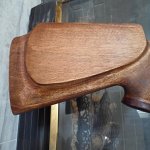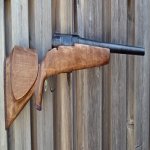I'm in the last steps of completing a scratch-built rifle stock from laminated Birch boards and frankly.... I'm getting sick of all the work involved 
I have no dreams of grandeur, it's a cheap project so I'm not looking for a showpiece just want it to look somewhat normal.
Yesterday, I sanded down to 220, applied Pre-Stain Conditioner and gave it a coat of stain, the endgrain turned horribly dark... I then resanded the endgrain with up to 1000 sandpaper, reapplied conditioner and stain, it somewhat fixed the problem.
This morning, after drying, I noticed a distinct "ring" of light-coloured wood all around the edge of the cheekpiece, obviously I screwed something up.
My question is this: Should I now sand down the lighter ring down to bare wood and try restaining? Could it be that I oversaturated the "ring" with conditioner ? Thanks in advance.
I have no dreams of grandeur, it's a cheap project so I'm not looking for a showpiece just want it to look somewhat normal.
Yesterday, I sanded down to 220, applied Pre-Stain Conditioner and gave it a coat of stain, the endgrain turned horribly dark... I then resanded the endgrain with up to 1000 sandpaper, reapplied conditioner and stain, it somewhat fixed the problem.
This morning, after drying, I noticed a distinct "ring" of light-coloured wood all around the edge of the cheekpiece, obviously I screwed something up.
My question is this: Should I now sand down the lighter ring down to bare wood and try restaining? Could it be that I oversaturated the "ring" with conditioner ? Thanks in advance.









































































